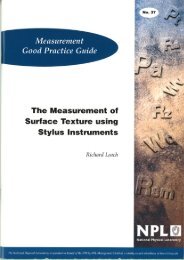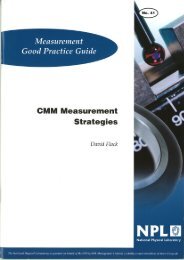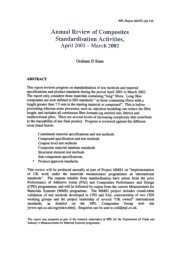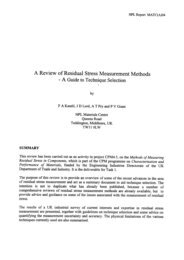Dimensional Measurement using Vision Systems - NPL Publications ...
Dimensional Measurement using Vision Systems - NPL Publications ...
Dimensional Measurement using Vision Systems - NPL Publications ...
Create successful ePaper yourself
Turn your PDF publications into a flip-book with our unique Google optimized e-Paper software.
<strong>Measurement</strong> Good Practice Guide No. 39<br />
2.4.3 Flat field objective<br />
Field curvature of the image is obviously extremely undesirable when an objective is being<br />
used for photomicrography or for dimensional measurements. Unfortunately, ordinary<br />
achromat and apochromat objectives suffer from curvature of field, which tends to become<br />
more marked as the objective power increases. Flat-field objectives (frequently designated<br />
'plan' objectives) were therefore developed to overcome this limitation; they are available<br />
with achromatic, fluorite or apochromatic correction but, in general, their chromatic<br />
correction is somewhat poorer than that of the 'curved field' design.<br />
2.4.4 Objectives with freedom from lateral chromatic aberration<br />
Many types of microscope objective possess transverse chromatic aberration i.e. the image<br />
magnification produced by the objective is slightly wavelength dependent, being greater<br />
for blue light than for red. Images of objects near the edge of the field will then exhibit<br />
slight colour fringing, a dark object having a red fringe on its outer side and a blue fringe<br />
on its inner side. Most high power objectives (x40 and over) and almost all flat-field<br />
objectives exhibit some transverse chromatic aberration and this is corrected by <strong>using</strong> a<br />
compensating eyepiece specially designed to offset the objective aberration. Newer<br />
designs of microscope objectives are available where transverse chromatic aberration has<br />
been corrected independently in both the objective and eyepiece, leading to excellent<br />
colour correction over the whole field of view. A compensating eyepiece should obviously<br />
not be used with this type of objective.<br />
2.4.5 Biological and metallurgical objectives<br />
Biological specimens are usually examined with the sample covered by a glass coverslip<br />
0.17 mm in thickness. This thin parallel-sided plate will itself introduce spherical<br />
aberration, which must be compensated for in the objective design. In contrast, in the<br />
metallurgical and microelectronics fields, no coverslip is usually employed. Manufacturers<br />
therefore offer two series of objectives, one for biological and the other for metallurgical<br />
applications. As the spherical aberration introduced by the coverslip increases rapidly<br />
with the obliquity of the light rays, deterioration of image quality becomes more marked<br />
at higher numerical apertures if the wrong type of objective is employed. For numerical<br />
apertures of 0.35 or lower, the choice of objective type is not critical and, in fact,<br />
manufacturers generally produce only one series of low power objectives.<br />
11
















